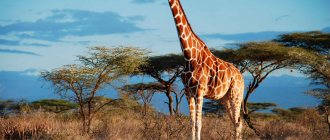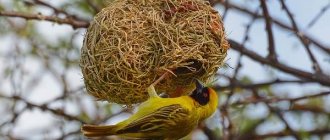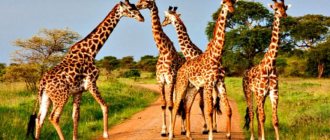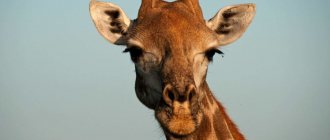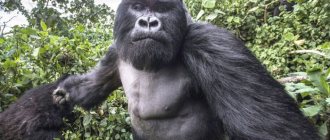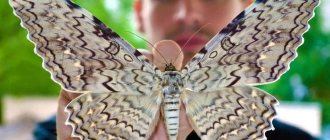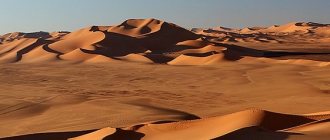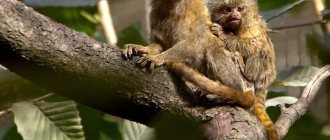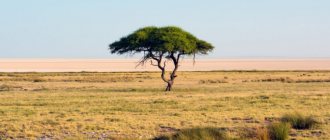Giraffes are the world's tallest mammals. Adults can reach 6 meters in height and weigh up to 2000 kg. Sizes that, combined with their color, give them a unique and beautiful appearance. All species and subspecies that live today have different coat colors. And we can say even more: each giraffe has a unique pattern that is never repeated in another individual, like our fingerprints.
We are sure you will be interested in reading interesting facts about squirrels, cats, pigs, penguins
They are uniquely adapted to access vegetation inaccessible to other herbivores. Their unusually elastic blood vessels and specially adapted valves help compensate for the sudden pooling of blood (apparently to avoid fainting) when giraffes' heads rise, fall or swing rapidly.
There are four species that grace African landscapes, and although they are similar to each other, each has its own characteristics.
Types of giraffes
There are four main types of giraffes:
- Masai giraffe
Considered the largest subspecies, these individuals are called the tallest animals on Earth. Lives in Tanzania and Kenya. Small spots in the shape of teeth, the shape of the skull and huge size are the main features of the appearance of this animal.
Masai giraffe
- Southern giraffe
The species with the largest abundance at the moment. South African giraffes, as their name suggests, live primarily in South Africa. The habitat may also include Zimbabwe, Mozambique and Namibia. The spots spread throughout the body and have a reddish tint with a rounded shape.
Southern giraffe
- Reticulated giraffe
The giraffes that everyone sees in zoos often belong to this subspecies. In the wild there are approximately 8500-9000 individuals. The color of the skin consists of many large charcoal-shaped spots, the color is mainly brown or brown, the spots themselves are outlined by a grid of white lines. Habitats are tropical forests of the hot continent and savannas of the Horn of Africa.
Reticulated giraffe
- Nubian giraffe
A rare species of giraffe, listed in the International Red Book. They are completely extinct in the wild and are strictly protected. Differences from other individuals include more pronounced cartilaginous growths on the head of males and chestnut spots. Previously, they were widespread throughout northern Africa, from Egypt to Sudan. Just like reticulated ones, they prefer forests and savannas as habitats. Currently, they can only be found in eastern South Sudan and southern Ethiopia. Only one zoo in the world breeds them, Al Ain Zoo in Abu Dhabi.
Nubian giraffe
There are several more subspecies, for example, Rothschild's giraffe
, which is also often found in zoos. But all the remaining individuals are not recognized and are not included in the classification, since they do not have any special features other than their numbers and range:
- West African Giraffes –
They used to exist throughout West Africa, but are now only found in Chad. - Thornycroft's giraffes
live in Zambia, and to be precise, in the Luangwa Valley, they are also called Rhodesian giraffes. - The Kordofan giraffe
lives in the eastern part of western Sudan and the Central African Republic. - Angolan giraffe's
habitat is considered to be Namibia and Botswana. - The Ugandan giraffe
, better known as the Rothschild giraffe, exists only within Uganda.
Habitat
Numerous archaeological finds indicate that the giraffe-like animal (as described) was common in the Nile River Delta. However, back in the era of Ancient Egypt, this population was destroyed.
Today the habitat of giraffes is in Africa. However, they do not live compactly on this continent, but are scattered throughout it. And a certain area is home to one of nine subspecies, each of which differs from the others in its coat pattern. This happened because the environment required maximum adaptation to its landscape and conditions.
For example, the Angolan giraffe has the palest coat color, as it is almost identical to the color of desert sand. It should be noted that these tall animals are able to do without water for quite a long time, but this is a difficult test for them. During the day, the heat in the desert is unbearable, and at night the temperature can drop to 0 degrees. However, there is a positive aspect to this: the formation of night fog ends with the fall of dew, which settles on the leaves of the sparse vegetation. This is how giraffes replenish the lack of fluid by licking the drops.
So, moving from tree to tree, animals can reach the nearest body of water.
What does it look like
The main feature that distinguishes giraffes from all other animals is their long neck and, in principle, height. But, even taking into account such huge sizes, the giraffe’s spine does not differ from standard characteristics and has 7 cervical vertebrae, like any other mammals, as well as humans. The giraffe's color is filled with spots that form a special pattern that is never repeated in another individual. The head has horns covered with skin and fur, eyes located on the sides for good vision, and long eyelashes that some people find quite attractive.
Giraffe skeleton
Many people think that thin legs do not allow giraffes to move quickly, but this opinion is erroneous - the average speed of the animal is 60 km/h, and the jump height is more than one and a half meters. The running itself looks rather clumsy and cannot last for a long time, so basically the animals walk smoothly and only in case of danger do they go into a gallop.
The spots on the body are not only decoration, but also excellent camouflage in the environment - they imitate the play of light and shadow in the leaves of trees, due to which, even with its size, the animal can perfectly hide from predators.
Another feature of the appearance is the tongue, which has a dark blue, purple or even brown color, thanks to which long exposure to the sun does not cause harm. It is with the tongue that giraffes grab their food, so it has strong muscles and can stretch half a meter, which allows the animal to even clean its own ears.
Safety precautions
The giraffe has something to fear. Firstly, due to its growth, it is vulnerable in the event of a thunderstorm, as a target for a lightning strike. Secondly, as we know, there are lions. Thirdly, high slopes are a serious obstacle for a giraffe. He may lose his balance, and then this “high tower” will collapse. It is known that only two living creatures can fall at risk to their lives - a giraffe and a person.
Therefore, before this tall handsome man decides to climb a high slope, he will first inquire about the availability of a safer and gentler path.
The giraffe's lifestyle is traditional for animals living in places where rain is the greatest rarity and water is the greatest treasure. They move from place to place in search of food, like all herbivores. Other animals, which do not have such a long neck, and, therefore, have a less extensive view of the territory, try to stay close to them. The giraffe, thanks to its height, is the first to detect danger and begins to retreat, and the others, looking at it, also take precautions.
You might be interested in:Are pandas dangerous to humans? Don't tease the bamboo bear!
By the way, how many vertebrae do you think are in a giraffe's neck? You will be surprised, but there are as many of them as you have - seven. This is a case where size matters.
Giraffe height and weight
The growth of a giraffe can reach 6 meters, two of which will fall on the neck, famous for its length. Weight ranges from 500 kg to two tons, for comparison we can cite a passenger car, the weight of which rarely reaches at least 1500 kg, which means that an adult giraffe is two cars. To maintain such dimensions, the animal has to eat more than fifty kg of food daily and drink ten liters of water. The giant's heart weighs on average 10-12 kg, and its valves move more than 50 liters of blood per minute. The pressure in the vessels is three to four times higher than human pressure, which is why even a sharp turn of the head can lead to disastrous consequences.
How long do giraffes live?
In the wild, these animals live an average of 25 years; the current record age holder is the 28-year-old giraffe Samson from the Moscow Zoo. In captivity they can live up to thirty years. The unsurpassed record holder is Luga, a female from the Leningrad Zoo, who died several years ago, in 2022. Her age was 35 years old, which is still considered an unimaginable number.
Method of communication
Researchers have long been trying to understand the principle by which communication between giraffes is built. It has been noted that these animals rarely make any sounds, however, babies can moo or bleat, and males growl while fighting for a female. In addition, giraffes can snore, moan, hiss, and even imitate the sounds of a flute.
The communication of these animals is completely impossible for humans to overhear, since the frequency of the sounds produced is below 20 Hz. Therefore, scientists use special sensors, with the help of which it is possible to get at least some idea of the conversations of giraffes among themselves. By the way, they prefer to talk at night.
How do giraffes sleep?
Giraffes, like most other mammals, sleep at night. They lie down on the ground, tuck one of the hind legs and both front legs towards themselves, and stretch the remaining one to the side, after which they lay their head on it. This position allows you to quickly get up when you sense danger. In this case, the neck bends back due to its size, resembling an arch. Giraffes have intermittent sleep, so they often get up in the middle of the night and then go back to bed. The deep phase of sleep is very short in duration and often does not exceed 30 minutes per night.
Where does it live?
The savannahs of Africa are considered to be their natural habitat, outside of which this animal can only be found in zoos. Due to its low water consumption, it can sometimes be found in open forests and dry areas of the continent.
It is surprising that millions of years ago the ancestors of the giraffe could have existed not only on the hot continent, but also in Europe and Asia.
What does it eat?
The main food for giraffes is the foliage of trees and shrubs, but acacia is considered their favorite delicacy. The “competition” between these two takes place over millions of years of evolution, during which both opponents adapt to each other. The tree has thorns, hooks, thorns and a high percentage of toxic substances with a pungent taste, and the giraffe has a long tongue with many receptors, especially thick saliva with a huge amount of enzymes that can digest even cactus thorns, a liver that produces poison-neutralizing substances and skills recognition of the most caustic leaves. The appearance of the tree is also attractive, on which, at the end of the drought, white flowers appear with a pleasant smell, attracting all the animals in the area, including giants.
The black acacia deserves special attention, as it has even learned to reproduce with the help of these animals. During evolution, sharp thorns appeared on it, but the flowers still remained defenseless, which allows giraffes to eat them without any problems. When the world's tallest animals eat flowers at a height of four meters, they are covered from head to neck in pollen, which is then carried to many other trees. Thus, the acacia does not lose much of its population and continues to exist, reproducing with the help of its “enemy.”
Continuation of the family line
Sexually mature females, as a rule, do not leave the herd, which cannot be said about adult males, who can go on a solitary “voyage.” However, the time “X” comes, and males rush to where there are girls to have offspring.
But not everything is so simple: first you need to pass the casting, show what you are capable of, and only then...
So, to the question of the giraffe’s neck: there is a theory according to which in the mating fight between males, the specimen with the longest neck won. In reality, giraffes deliver very sensitive blows to their opponents with this part of the body. It can even lead to death.
They also use a cunning technique: with the help of their neck they grab the opponent’s leg so that he remains on three, loses his balance, falls, and the winner takes everything.
Natural enemies
The size of the giraffe prevents most predators from causing any harm to it. As a defense, the giant uses its front hooves, the blow of which can break the skull of any predator, regardless of its speed and strength. It is precisely because of this terrifying power that adults are not attacked - they are simply feared. But hyenas, leopards and lions can target young animals that are not difficult to kill, which is why only 25-50% survive to adulthood.
The most protected and strongest place in the body of this animal can be safely called the neck, the muscles of which can withstand enormous loads and a third of the weight of the entire giraffe. Therefore, predators try to attack thin legs, breaking which the animal will no longer be able to stand up and give any resistance, because it is the front hooves that are the main means of defense against attacks.
But sometimes there are exceptions, for example, an incident in a nature reserve in northern Namibia, which was reported by eyewitnesses: lions jumped on a giant and bit his neck, causing him to fall lifeless.
Much worse for giraffes are insects like fleas, which are always trying to settle on the giant’s body. The animal’s long tail helps it brush them off, and if that doesn’t help, then birds come to the rescue: starlings and other birds will clean the skin without any problems, but they can cause infection, so people watch everything closely.
About the benefits of language
The regions of Africa are not gardens of Eden with fruits littering their branches. If there is vegetation here, it protects itself in every possible way, for example, with long thorns. These are the different types of acacia, the leaves of which the giraffe feeds on. How does he protect himself from long needles? Firstly, his eyelashes perfectly protect his eyes from danger. And secondly, the giraffe’s tongue, which is up to half a meter long, is adapted for reaching leaves, penetrating through acacia thorns.
The structure and color of this important organ deserve special description. In addition, with its help, the giraffe can not only obtain food, but also destroy annoying insects, of which there is an overabundance in the savanna. The color of the tongue varies from purple to black, and it is quite muscular.
You may be interested in: Animals and birds of the north: how do they adapt to the cold? Birds of the Far North of Russia
Giraffes can get enough of six kilograms of various types of vegetation, but in fact they eat much more. Almost their entire working day, ranging from 16 to 20 hours, is devoted to obtaining food.
Character traits
Giraffes are not aggressive animals that, even in case of danger, would prefer to run away than to fight back. Their ability to communicate is also amazing - they can transmit information among themselves at a frequency of less than 20 Hz, which cannot be detected by human and, in some cases, even canine hearing.
Males often move in search of females who are interested in them: they can travel up to 20 km per day to find their love. The largest male often tries to take all the attention of the opposite sex to himself, not allowing smaller or younger ones to approach them. If the “alpha” comes across someone who wants to get a female on his way, he takes a fighting pose, stretching his neck vertically and straining his front legs, putting them towards his enemy. If the other male does not begin to retreat, then a duel begins, in which the main weapon is the neck. Mammals head-butt each other's bodies, intending to knock them down. The loser tries to retreat, but the dominant begins to chase for several meters, and then freezes in a victory pose with his tail raised up.
Dangerous neighbors
It can be said that the giraffe is a species perfectly adapted to life in the desert, since its coloration allows the animal to blend into the landscape. Moreover, 9 types of color combinations are known, varying depending on the territory of residence of this giant.
But who is the giraffe trying to avoid given its massive weight and cloven hooves on strong legs, the length of which, by the way, reaches 180 cm? Are there many people willing to enter into an argument with him in the desert or on the expanses of the savannah?
In fact, there is only one danger for this six-meter giant - a lion, and even then only if he hunts with a pride. Alone, this could end sadly for the king of beasts. The fact is that a giraffe's most important weapon is its legs. Their blow is almost fatal, and the lions know it. Therefore, the hunt for a giraffe begins only collectively and only when common sense is overwhelmed by a feeling of hunger.
In terms of speed, an animal with a long neck is inferior to lions, since it runs about 56 km per hour, while the king of beasts can reach 80 km, but only over short distances. And the giraffe is a stayer, so if the lion does not have time to overtake it in the first minutes of the pursuit, then the pursuit is already useless.
Lifestyle
Giraffes are considered diurnal inhabitants. They eat food in the early morning and also in the afternoon. Their hottest hours are spent in a state of half-sleep somewhere in the shade of trees. At these moments they have gum in their mouth, which they like to chew, their eyes are slightly closed, but their ears are always alert. The main sleep takes place at night, during which they lie down in a specific position from which they can quickly get to their feet.
Basically, these mammals are united in groups, the number of which does not exceed 20-25 individuals. Their composition is not constant; animals can join and come to them at will. A special connection can be seen between babies and females: they try to protect weaker and not yet independent children, risking their own lives. When they are in open areas, they try to gather in crowds, and when they eat, they disperse in all directions.
Adults are actively looking for a female, but they come across dominants who do not provide a normal life for animals desiring attention. It is because of the strong representatives of the species that duels often occur within groups.
In dry weather and at its height, when there is less food, the groups are divided into small groups of 5 individuals to make it easier for them to feed themselves, and in the rainy season they unite again, since there is enough food.
Giraffes can graze for 12 hours a day, mainly during sunset or dawn, when the sun's rays are not so intense. You can often hear them called "pluckers" - this name comes from their method of obtaining food. They literally pinch flowers, foliage, young shrubs and trees with their tongues, feeding at a height of two to seven meters. They can bend over for grass only because of the young shoots that sprout during the heavy rainy season. Wherever the animal lives, it will still give preference to its favorite delicacy - acacias. The giants only add other types of plants to their menu for the second time in order to replenish their water or vitamin reserves. In severe drought, they can feed on cacti and fallen leaves.
They have long hairs on their lips, from which a signal is sent to the brain, indicating the degree of maturity of the leaves and the presence of some toxic substances in them. The tongue is strong, mobile, reaches 50 cm in length and can slip among the spines. By pulling branches with the largest amount of food to its upper lip, the papillae on the edges of the lips allow it to hold the desired plant in its mouth, which the giraffe subsequently cuts off using its lower jaw. The giant stretches the smoother branches deeper, where there is free space, and then tears off all the leaves without harming the bark.
A feature of all ruminants is the repeated chewing of any food, due to which the food is absorbed several times faster. Giraffes have a unique ability: they can chew food even while moving, which means their grazing time increases significantly.
Compared to their height and weight, males of this family need 50-60 kg of greens per day, and females need even less - up to 45.
Giraffes' food has a huge amount of useful substances and consists of more than 50% water, so they almost never have to additionally replenish their water balance, but they still sometimes like to drink clean water. In rare cases, they also have to eat the soil due to the lack of the necessary mineral salts in their body, but there is plenty of them in the soil.
For a long time, people believed that this species of mammals did not have a voice, but they were wrong. Scientists have proven that they have a normal vocal apparatus, allowing them to produce a huge range of sounds. In case of danger, they can cry out, releasing air through their nostrils; in a fight or when excited, the males cough or growl. It may even be that at the peak of orgasm they may roar. The cubs, frightened, begin to scream pitifully without opening their mouths, thereby calling older males or females to them, who will aloofly save their child.
Reproduction
Giraffes do not have a specific mating season. Males wander from one group of females to another, sniffing them and assessing their readiness to reproduce. It requires the strongest and largest males, since they simply will not allow the rest to meet the females, and their offspring are born weak, which is why they quickly die. The gestation period in animals lasts for one and a half years. Twins practically do not appear, so over time one cub is born.
The baby's height at birth is about two and a half meters and weight is 70-80 kg. Due to the fact that the female continues to stand during childbirth, the cub falls from a height of two meters immediately after birth. A few minutes after birth, a newborn tries to rise to his feet, and an hour later he tastes his mother’s milk. Giraffe babies develop quickly; within a week or two after birth, they run and jump no worse than adults. At the age of about a month, the baby tries to eat plant foods, but feeding with milk continues until the giraffe is one year old. The female tries with all her might to protect her calf from predators, but approximately half of all giraffes born within a year become food for lions or hyenas.
Immediately after birth, animals do not have horns on their heads, but the place where they appear is indicated by tufts of black hair, under which a cartilaginous process is already beginning to form. Subsequently, it becomes harder, ossifies and ultimately turns into small horns, which grow larger with age. The fur remains on them for several years, but then wears off and disappears completely.
The formation of a “kindergarten” can be called a fairly common occurrence. Females and even males collect all the babies in the area and do not allow anyone to come even close to them, protecting them from any potential threat.
Giraffes separate from the family after 16-18 months, becoming more or less independent and joining groups of other young animals.
Population and species status
Giraffes are rightfully considered the personification of calm and the calling card of Africa; they get along well with people and are quite peaceful. Even in ancient times, the aborigines had difficulty hunting these giants of the world fauna, so they were never the main prey. But having killed this animal, they tried to use every part of it to the maximum. The meat was eaten, the sinews served as excellent strings and strings for bows, the skins were shields or material for clothing, the hair was used as tassels for creativity, the tail could serve as decorations for the home or as bracelets.
There used to be a lot of giraffes; they inhabited almost all continents of Africa before the advent of colonialists. These people brought destruction to many places and exterminated many animals, and the tallest mammals were no exception. They were killed for the sake of skins and leather, which were sold or used for belts, whips were woven from it, carts were strengthened and many other items that people thought were necessary.
Subsequently, hunting turned into full-fledged poaching and barbarism; settlers from Europe began to brutally kill animals not even for the purpose of profit, but simply for their own pleasure. They felt a thirst for blood and adrenaline rushed into their heads, because they were able to kill giants, whom even lions were afraid of. They were killed in tens and hundreds, driven into safari, and the tails of the corpses were cut off as a trophy, leaving the rest of the body to rot.
The result of such atrocities on the part of people was a reduction in the giraffe population several times. Now they are practically not hunted, because even wild habitats are under strict state protection, but the number continues to decrease every year due to another problem - deforestation and destruction of habitats familiar to these animals.
At the moment, there are only two genera in the Giraffidae family: the giants themselves and modern small artiodactyls called okapi or Johnston's okapi. In terms of their physique, they do not stand out in size, so they are more like horses with the head of a giraffe and stripes on their legs, like a zebra. These relatives live in the Democratic Republic of the Congo, outside of which they are not found. The number is unknown, but according to rough estimates it ranges from 30-35 to 50 thousand. There are no more than two hundred of them in zoos around the world.
Armed neutrality
Among the inhabitants of the desert, the giraffe is not the largest animal. Elephants compete with him in this. They also feed on vegetation, and therefore compete with giraffes for tasty places and bodies of water. These two giants do not directly attack each other, but the elephants do not miss the opportunity to demonstrate their strength. However, the giraffe does not fall for these stupid games, especially if it happens near a watering hole. The tall handsome man will simply wait patiently for the elephants to get drunk and free up space.
Then an acrobatic sketch begins: how many vertebrae are in the giraffe’s neck, the number of vertebrae he must lower to the surface of the reservoir. This cannot be done without involving the legs. And in this position, the long-necked animal looks like a cabinet with legs placed at an angle of 45 degrees.
A giraffe can tilt its head only for a minute, but this time is enough for it to draw in several liters of water. A sudden rise follows, but valves in his veins prevent him from losing his balance. This happens several times until the animal’s body replenishes the multi-week loss of fluid. Next, the giraffe goes in search of food.
Why are animals called that?
If you've ever wondered why mammals with giant necks are called "giraffes", then the answer is quite simple. In many languages, the name is constructed in comparison with a camel, for example, translated from Latin it means “camel-panther”. The name came to the Russian language from the French language - it is a borrowed word giraffe. The French named the animal this way after meeting a female, Zarafa, who arrived from Egypt, who subsequently lived in the Paris Zoo for eighteen years. Her nickname translated meant “elegant” or “fabulous.” In 2013, a cartoon called “Giraffe” appeared in France, which took this story as a basis.
Interesting facts about the tallest land animals on Earth:
- Giraffes don't yawn. Not a single scientist in the world has yet been able to see a giraffe performing this action, although they are monitored everywhere and 24 hours a day.
- The heart of a mammal moves more than fifty liters of blood per minute, which is surprising, because they even eat less in volume in a whole day. The heart muscle itself weighs up to 12 kg, and the pressure inside it can exceed human pressure three times.
- One giraffe somewhere in a zoo happily ate raw onions, after which enthusiasts tried to do the same thing several times with several individuals, and absolutely every one of them feasted on this product.
- We know that the neck of this animal is a third of its height, its tongue is half a meter and its height itself is about six, or maybe even more. But what is also surprising is the length of the tail, which on average varies from two to three meters.
- It can also be called strange that the mammal’s neck is still not long enough to drink water from a reservoir or snack on grass, so they kneel down and only then can they begin to replenish their water reserves.
- Unlike young representatives, who are hunted by leopards and hyenas, only the king of all animals, who is famous for his fearlessness, risks attacking adults.
- Although they feed for twelve hours, in fact, 6-7 kg of food is enough for them to live a normal life. They just don’t know what to do with themselves, so they eat almost all their free time.
